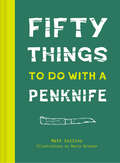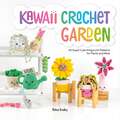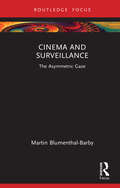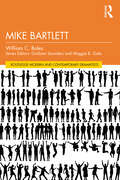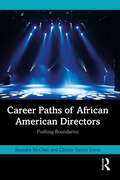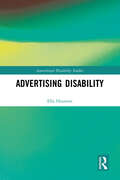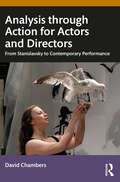- Table View
- List View
Crochet Illusion Blankets: 15 patterns for optical illusion crochet blankets, afghans and throws
by Helen SmithA collection of eye-catching 3D effect crochet patterns for different sized blankets and throws, that all have an optical illusion effect. These cleverly designed geometric blankets look impressive but are actually simple to make because the designer only uses one technique, intarsia crochet, and simple stitches.There are 15 different designs in a variety of sizes from smaller throws through to large afghans. All of the crochet blanket patterns are written out in full and there are large charts for each of the designs for crocheters who prefer to follow charts.All of the blankets are made with Scheepjes Truly Scrumptious aran-weight yarn, which is made from recycled plastic bottles. This means that the blankets work up quickly and have a lovely drape as well as being visually striking.All of the patterns use the crochet intarsia technique and there instructions for how to prepare your yarn in separate balls before you get started so you don’t end up in a tangle. There are also step-by-step instructions for how to work crochet intarsia including advice on changing colour.Please note that the patterns are written using US crochet terms, but there is a conversion table for UK terms, along with US/UK hook sizes, at the front of the book.The blanket projects include a variety of sizes, with the largest measuring 51 x 36 inches. There are instructions for how to increase the size of the blankets by adding a border as well as decorative details including tassels and pom poms. There are also instructions for how to alter the drape of the blankets by changing the hook size you use.The ‘Getting Started’ section explains the concept behind the illusion blanket designs and the importance of colour, with advice on choosing alternative colours. This is illustrated with photos of swatches showing variations of the same design with alternative colour combinations.The front section includes information about what the best yarns and hooks to use are as well as the other tools and materials featured. The General Techniques includes step-by-step instructions and diagrams for the basic stitches as well as the finishing techniques that will ensure your blankets look their best.
Fifty Things to Do with a Penknife: The Whittler's Guide To Life
by null Matt CollinsA beautifully presented, practical gift guide to the age-old art of whittling. There are 50 projects featured in the book, ranging from quick makes to more elaborate projects, and even a chapter on creating things from cork. The 8 main themes are: Quick Things – including a doorstop, a bookmark and a gift-box book; Into The Woods – including a willow whistle, walking stick, fish hook and slingshot; Around The House – including chopsticks, coat and crochet hooks; Cork Creations – including a succulent pot, stamp, and earphones spool; Ornamental Carving – including a boat, a deer and a spinning top; Kitchen Carving – including a carrot flute, apple candle and onion flower; The Natural World – including a bird feeder and instructions to prepare a fish for cooking, a graft an apple tree. The projects cater for a range of skill levels and the instructions are complemented by smart step-by-step illustrations, which highlight the tactile quality of the material in hand. The book also includes an introduction with advice on selecting a penknife, maintaining your blade, choosing your caving material, and carving techniques. Featuring the ultimate crossover of cool craftsmanship and savvy survival-skill projects, this book is the perfect gift for creative adventurers.
100 Knitted Tiles: Charts and patterns for knitted motifs inspired by decorative tiles
by VariousA collection of 100 knitting charts and patterns for designs based on decorative tiles.Decorative tiles have long been a source of inspiration for designers and artists due to their often intricate patterns and colours. This collection of knitting patterns and charts includes 100 designs inspired by decorative ceramic tiles from around the world.Choose from brightly coloured colourwork designs to simple textured motifs that evoke everything from Victorian floor tiles to the intricate and brightly coloured designs of ancient temples and palaces.Using a variety of different colourwork knitting techniques such as stranded knitting, mosaic knitting, and intarsia, as well as textured and lace knitting techniques and special stitches, a number of talented knitting designers have developed their own interpretations for you to create with yarn.All of the tiles are made using Metropolis, a 4 ply yarn by Scheepjes but you can supplement it with any 4ply yarn that meets the gauge (tension) recommendations. These knitted tile patterns are the perfect stash buster projects as they only use small amounts of yarn and they're a great way to try out different knitting techniques on a small scale.The tiles are constructed using a number of different knitting techniques including working in rows, modular knitting and centre out knitting so there are lots of different methods to try. All the knitting stitches and techniques you will need to make the motifs are included in the techniques section along with helpful step-by-step artworks and instructions.In addition to the motif patterns there are instructions for five knitting projects to show how specific tiles can be used to make blankets, pillow cases, a needlecase and a knitted bag. Or why not mix and match your favourite designs to create your own blankets or throws? This unique collection of 100 exciting designs will continue to inspire and delight knitters of all abilities.
Alice's Wonderland Sampler Quilt: 100 quilt blocks to improve your sewing skills
by Alice CarolineThe exquisite Alice's Wonderland Quilt combines a variety of quilting techniques in one stunning sampler quilt which features 100 blocks. Using a variety of machine and hand-sewn techniques, this quilt will improve your sewing skills.Gorgeous patchwork designs such as square-in-a-square, checkerboard, log cabin and Ohio Star combine with beautiful English paper-pieced blocks and raw edge applique animals, flowers, butterflies, hearts and stars.Starting with the simplest patchwork techniques and building from there, you will learn one or two basic techniques across ten different blocks, each one creating completely different patterns simply by using new arrangements and placements. Full sized EPP and applique templates, including Alice's hand-drawn designs, are provided. Each block forms a 6-inch square which then joins together at the end with the other blocks to make the finished quilt comprising of 100 beautiful blocks.After you have made your main blocks, the stunning rainbow border of the quilt is added. It includes a double rainbow border, an ivory border, and a further square-in-a-square rainbow border using prints from the main quilt to tie the whole colour scheme together.Featuring step-by-step illustrations for all the techniques and full-size templates, this stunning sampler quilt will build your skills and leave you with a treasured heirloom to pass on down the generations.
Kawaii Crochet Garden: 40 super cute amigurumi patterns for plants and more
by Melissa BradleyCrochet a garden of kawaii happiness with this super-cute collection of 40 amigurumi patterns! Let Melissa Bradley of Yarn Blossom Boutique lead you down the garden path to discover a colorful world of crochet flowers, plants and garden creatures with this blooming marvellous book. Plants and flowers make everyone smile, but never more so than when they are made out of crochet with sweet little faces. This adorable collection of patterns will fill your world with everlasting flowers, without having to do any digging whatsoever. Cultivate your color knowledge and a bumper crop of makes, perfect to bring the outdoors in and to give as gifts. As well as the patterns, Melissa shares all the know-how on the simple crochet techniques required for everything to come up roses. Alongside the flowers and plants, you'll spot cute bugs and gardening tools, brought to life kawaii-style, to create the ultimate garden-lovers collection. As in her first book Kawaii Crochet, Melissa breaks the patterns down by color with chapters for Pink, Red, Orange, Yellow, Green, Blue, Purple and White, with favorite plants and flowers in each section. You'll find step-by-step patterns for crochet tulips, roses, pansies, poppies, gerberas, daffodils, sunflowers, marigolds, delphiniums, daisies, violets, lilies and more, plus potted foliage in the form of cacti, ferns and string of pearls. And making an appearance in each chapter are cute creatures such as worms, ladybugs, snails, caterpillars, beetles and moths, and a few gardening tools too. The plants are presented either as bulbs or in colorful pots and vases, making them absolutely perfect for giving as gifts. At the back of the book you'll find full tutorials with photos and diagrams on how to work the crochet stitches, how to add the faces, and how to make your flowers stand up tall with wire hidden inside the stems. This flowery collection is the perfect addition to any crochet and amigurumi lover's library - with gorgeous photography, easy, tried and tested patterns, and cute doodle illustrations and tips to amuse you while you stitch. Let Kawaii Crochet Garden fill your world with flowers!
Cinema and Surveillance: The Asymmetric Gaze (Routledge Focus on Film Studies)
by Martin Blumenthal-BarbyCinema and Surveillance: The Asymmetric Gaze shows how key modern filmmakers challenge and disturb the relation between film and surveillance, medium and message. Assembling readings of films by Harun Farocki, Michael Haneke, and Fritz Lang, the book considers surveillance in such different domains as urban life, religious doctrine, and law enforcement. With surveillance present in the modern world as both a technological phenomenon and a social practice, the author shows how cinema, as a visual medium, presents highly sophisticated analyses of surveillance. He suggests that “surveillance” is less an issue to be tackled from a secure spectatorial position than an experience to be rendered, an event to be dealt with. Far from offering a general model of spectatorship, the book explores how narrative moments of surveillance are complicated by specific spectatorial responses.In its intersection of well-known figures and a highly topical issue, this book will have broad appeal, especially, but not exclusively, among students and scholars in film studies, media studies, German studies, European studies, art history, and political theory.
Cinema and Surveillance: The Asymmetric Gaze (Routledge Focus on Film Studies)
by Martin Blumenthal-BarbyCinema and Surveillance: The Asymmetric Gaze shows how key modern filmmakers challenge and disturb the relation between film and surveillance, medium and message. Assembling readings of films by Harun Farocki, Michael Haneke, and Fritz Lang, the book considers surveillance in such different domains as urban life, religious doctrine, and law enforcement. With surveillance present in the modern world as both a technological phenomenon and a social practice, the author shows how cinema, as a visual medium, presents highly sophisticated analyses of surveillance. He suggests that “surveillance” is less an issue to be tackled from a secure spectatorial position than an experience to be rendered, an event to be dealt with. Far from offering a general model of spectatorship, the book explores how narrative moments of surveillance are complicated by specific spectatorial responses.In its intersection of well-known figures and a highly topical issue, this book will have broad appeal, especially, but not exclusively, among students and scholars in film studies, media studies, German studies, European studies, art history, and political theory.
Estimator’s Pocket Book (Routledge Pocket Books)
by Duncan CartlidgeThe Estimator’s Pocket Book, Third Edition is a concise and practical reference covering the main approaches to pricing, as well as useful information such as how to process sub-contractor quotations, tender settlement and adjudication. It is fully up to date with the New Rules of Measurement (NRM2) (2nd Edition) throughout and based on up-to-date wage rates, legislative changes and guidance notes.The book includes instructions on how to carry out:· an NRM order of cost estimate,· unit-rate pricing for a range different trades,· pro rata pricing for variations, and· the preparation and pricing of builders’ quantities and approximate quantities.This book is an essential source of reference for quantity surveyors, cost managers, project managers and anybody else with estimating responsibilities.
Estimator’s Pocket Book (Routledge Pocket Books)
by Duncan CartlidgeThe Estimator’s Pocket Book, Third Edition is a concise and practical reference covering the main approaches to pricing, as well as useful information such as how to process sub-contractor quotations, tender settlement and adjudication. It is fully up to date with the New Rules of Measurement (NRM2) (2nd Edition) throughout and based on up-to-date wage rates, legislative changes and guidance notes.The book includes instructions on how to carry out:· an NRM order of cost estimate,· unit-rate pricing for a range different trades,· pro rata pricing for variations, and· the preparation and pricing of builders’ quantities and approximate quantities.This book is an essential source of reference for quantity surveyors, cost managers, project managers and anybody else with estimating responsibilities.
Mike Bartlett (Routledge Modern and Contemporary Dramatists)
by William C. BolesHailed as one of the most talented playwrights to have emerged in the late 2000s, Mike Bartlett's diverse range of plays strike at the heart of the various crises predominant in the early twenty-first century. Offering the first extensive examination of the plays and television series written by award winning playwright Mike Bartlett, this volume not only provides analysis of some of Bartlett’s best-known works (Cock, Doctor Foster, King Charles III, and Albion), but also includes new interviews with Bartlett and some of his closest and oft relied upon collaborators. In this book, Bartlett’s plays and television series are grouped together thematically, allowing the reader to observe the cross-pollination between his works on the stage and screen. The book also includes an introductory biographical chapter that discusses early influences on his writing (Harold Pinter, Mark Ravenhill, Tony Kushner, and Quentin Tarantino), his time in the Young Writers Programme at the Royal Court, and his work with the Apathists.Routledge Modern and Contemporary Dramatists is a series of innovative and exciting critical introductions to the work of internationally pioneering playwrights, giving undergraduate students an ideal point of entry into these key figures in modern drama.
Mike Bartlett (Routledge Modern and Contemporary Dramatists)
by William C. BolesHailed as one of the most talented playwrights to have emerged in the late 2000s, Mike Bartlett's diverse range of plays strike at the heart of the various crises predominant in the early twenty-first century. Offering the first extensive examination of the plays and television series written by award winning playwright Mike Bartlett, this volume not only provides analysis of some of Bartlett’s best-known works (Cock, Doctor Foster, King Charles III, and Albion), but also includes new interviews with Bartlett and some of his closest and oft relied upon collaborators. In this book, Bartlett’s plays and television series are grouped together thematically, allowing the reader to observe the cross-pollination between his works on the stage and screen. The book also includes an introductory biographical chapter that discusses early influences on his writing (Harold Pinter, Mark Ravenhill, Tony Kushner, and Quentin Tarantino), his time in the Young Writers Programme at the Royal Court, and his work with the Apathists.Routledge Modern and Contemporary Dramatists is a series of innovative and exciting critical introductions to the work of internationally pioneering playwrights, giving undergraduate students an ideal point of entry into these key figures in modern drama.
The Art of the Eurasian Steppe: Its Influence on European Cultures
by Peter HupfaufThe Art of the Eurasian Steppe is a contextual analysis which traces the stylistic transformation of artefacts depicting animals from various cultures of the Eurasian steppe, and investigates its possible influence on Central and Northern European art. A wide range of individual cultures are "visited" and their historic, cultural, and geographic specifics are explored. The survey in this book is based on a chronological structure, including an East-West geographic direction. This accommodates to position described artefacts of certain styles within time periods, cultures, and locations.Most of the existing literature related to cultures of the Eurasian steppe is specialised on one particular culture or one archaeological excavation. The book is written as a hypothetical journey through time and space, structured in an east to west direction. It provides a wide-reaching overview by placing the discussed artefacts into a cultural, geographic, and chronologic frame, particularly the thousand years between 500 BC and 500 AD. Artistic expression and style are a central theme to explore possible relationships between civilisations of the Eurasian steppe and their influence on medieval Central and Northern European creation of artefacts.Academics in the fields of art history, archaeology, history, and fine arts will find this book compelling/useful.
The Art of the Eurasian Steppe: Its Influence on European Cultures
by Peter HupfaufThe Art of the Eurasian Steppe is a contextual analysis which traces the stylistic transformation of artefacts depicting animals from various cultures of the Eurasian steppe, and investigates its possible influence on Central and Northern European art. A wide range of individual cultures are "visited" and their historic, cultural, and geographic specifics are explored. The survey in this book is based on a chronological structure, including an East-West geographic direction. This accommodates to position described artefacts of certain styles within time periods, cultures, and locations.Most of the existing literature related to cultures of the Eurasian steppe is specialised on one particular culture or one archaeological excavation. The book is written as a hypothetical journey through time and space, structured in an east to west direction. It provides a wide-reaching overview by placing the discussed artefacts into a cultural, geographic, and chronologic frame, particularly the thousand years between 500 BC and 500 AD. Artistic expression and style are a central theme to explore possible relationships between civilisations of the Eurasian steppe and their influence on medieval Central and Northern European creation of artefacts.Academics in the fields of art history, archaeology, history, and fine arts will find this book compelling/useful.
Career Paths of African American Directors: Pushing Boundaries
by Saundra McClain Clinton Turner DavisCareer Paths of African American Directors is a collection of in-depth conversations with African American directors.These conversations provide an insightful overview of the interviewees’ work and artistic vision and explore their personal influences, aesthetic philosophies, directorial styles, and some of the creative successes they achieved while navigating the obstacles, challenges, and biases encountered while establishing their careers in American theatre. The directors are presented with similar core questions as well as pertinent questions related to their own aesthetics, philosophy, and career. Often, these selected directors’ productions are grounded in a non-European aesthetic and philosophy, and their directorial styles are refracted through the prisms of ethnicity, gender, race, and culture, thus bringing a fresh approach to their work and the art of directing.Career Paths of African American Directors will be of interest to actors, early career and established directors, and students of Acting, Directing, and Theatre Studies.
Career Paths of African American Directors: Pushing Boundaries
by Saundra McClain Clinton Turner DavisCareer Paths of African American Directors is a collection of in-depth conversations with African American directors.These conversations provide an insightful overview of the interviewees’ work and artistic vision and explore their personal influences, aesthetic philosophies, directorial styles, and some of the creative successes they achieved while navigating the obstacles, challenges, and biases encountered while establishing their careers in American theatre. The directors are presented with similar core questions as well as pertinent questions related to their own aesthetics, philosophy, and career. Often, these selected directors’ productions are grounded in a non-European aesthetic and philosophy, and their directorial styles are refracted through the prisms of ethnicity, gender, race, and culture, thus bringing a fresh approach to their work and the art of directing.Career Paths of African American Directors will be of interest to actors, early career and established directors, and students of Acting, Directing, and Theatre Studies.
Advertising Disability (Autocritical Disability Studies)
by Ella HoustonAdvertising Disability invites Cultural Disability Studies to consider how advertising, as one of the most ubiquitous forms of popular culture, shapes attitudes towards disability. The research presented in the book provides a much-needed examination of the ways in which disability and mental health issues are depicted in different types of advertising, including charity 'sadvertisements', direct-to-consumer pharmaceutical advertisements and 'pro-diversity' brand campaigns. Textual analyses of advertisements from the eighteenth century onwards reveal how advertising reinforces barriers facing disabled people, such as stigmatising attitudes, ableist beauty 'ideals', inclusionism and the unstable crutch of charity. As well as investigating how socio-cultural meanings associated with disability are influenced by multimodal forms of communication in advertising, insights from empirical research conducted with disabled women in the United Kingdom and the United States are provided. Moving beyond traditional textual approaches to analysing cultural representations, the book emphasises how disabled people and activists develop counternarratives informed by their personal experiences of disability, challenging ableist messages promoted by advertisements. From start to finish, activist concepts developed by the Disabled People's Movement and individuals' embodied knowledge surrounding disability, impairments and mental health issues inform critiques of advertisements.Its critically informed approach to analysing portrayals of disability is relevant to advertisers, scholars and students in advertising studies and media studies who are interested in portraying diversity in marketing and promotional materials as well as scholars and students of disability studies and sociology more broadly.
Advertising Disability (Autocritical Disability Studies)
by Ella HoustonAdvertising Disability invites Cultural Disability Studies to consider how advertising, as one of the most ubiquitous forms of popular culture, shapes attitudes towards disability. The research presented in the book provides a much-needed examination of the ways in which disability and mental health issues are depicted in different types of advertising, including charity 'sadvertisements', direct-to-consumer pharmaceutical advertisements and 'pro-diversity' brand campaigns. Textual analyses of advertisements from the eighteenth century onwards reveal how advertising reinforces barriers facing disabled people, such as stigmatising attitudes, ableist beauty 'ideals', inclusionism and the unstable crutch of charity. As well as investigating how socio-cultural meanings associated with disability are influenced by multimodal forms of communication in advertising, insights from empirical research conducted with disabled women in the United Kingdom and the United States are provided. Moving beyond traditional textual approaches to analysing cultural representations, the book emphasises how disabled people and activists develop counternarratives informed by their personal experiences of disability, challenging ableist messages promoted by advertisements. From start to finish, activist concepts developed by the Disabled People's Movement and individuals' embodied knowledge surrounding disability, impairments and mental health issues inform critiques of advertisements.Its critically informed approach to analysing portrayals of disability is relevant to advertisers, scholars and students in advertising studies and media studies who are interested in portraying diversity in marketing and promotional materials as well as scholars and students of disability studies and sociology more broadly.
Cities and Territories of the Western Roman Empire: 4th Century BC to the 3rd Century AD
by Ricardo González-VillaescusaThis book showcases the unique shape of urban development that took hold during the Roman Empire, beginning in the Mediterranean basin before spreading out across Europe, and offers a fresh perspective on the cities and territories of the Roman West.With the expansion of Rome came a particular form of social organisation: the Roman city. This book provides a basic introduction to Roman cities, not through the lens of architecture and urbanism, but from a social, legal, cultural, spatial, and functional perspective. It focuses on the Roman civitas – the city and its territory – as the spatial model par excellence of Roman colonialism and expansion. Exploring primarily the cities and territories of the Western Empire, such as the Iberian Peninsula, Gaul, and Britain, González-Villaescusa revives from their ruins those central places that facilitated the circulation of people, goods, and information, forming the large urban network of a unified imperial territory.Cities and Territories of the Western Roman Empire: 4th Century BC to the 3rd Century AD is suitable for school and university students, as well as the general reader interested in the subject of Roman cities in the Western Empire.
Cities and Territories of the Western Roman Empire: 4th Century BC to the 3rd Century AD
by Ricardo González-VillaescusaThis book showcases the unique shape of urban development that took hold during the Roman Empire, beginning in the Mediterranean basin before spreading out across Europe, and offers a fresh perspective on the cities and territories of the Roman West.With the expansion of Rome came a particular form of social organisation: the Roman city. This book provides a basic introduction to Roman cities, not through the lens of architecture and urbanism, but from a social, legal, cultural, spatial, and functional perspective. It focuses on the Roman civitas – the city and its territory – as the spatial model par excellence of Roman colonialism and expansion. Exploring primarily the cities and territories of the Western Empire, such as the Iberian Peninsula, Gaul, and Britain, González-Villaescusa revives from their ruins those central places that facilitated the circulation of people, goods, and information, forming the large urban network of a unified imperial territory.Cities and Territories of the Western Roman Empire: 4th Century BC to the 3rd Century AD is suitable for school and university students, as well as the general reader interested in the subject of Roman cities in the Western Empire.
Recent Developments in Structural Engineering, Volume 1 (Lecture Notes in Civil Engineering #52)
by Ratnesh Kumar Manmohan Dass Goel Sangeeta S. GadveThe book presents the select proceedings of 13th Structural Engineering Convention. It covers the latest research in multidisciplinary areas within structural engineering. Various topics covered include structural dynamics, structural mechanics, finite element methods, structural vibration control, advanced cementitious and composite materials, bridge engineering, soil-structure interaction, blast, impact, fire, material and many more. The book will be a useful reference material for structural engineering researchers and practicing engineers.
Climate Disaster Preparedness: Reimagining Extreme Events through Art and Technology (Arts, Research, Innovation and Society)
by Michael J. Ostwald Ursula Frohne Dennis Del Favero Susanne ThurowAs a result of global warming, extreme events, such as firestorms and flash floods, pose increasingly unpredictable and uncertain existential threats, taking lives, destroying communities, and wreaking havoc on habitats. Current aesthetic, technological and scientific frameworks struggle to imagine, visualise and rehearse human interactions with these events, hampering the development of proactive foresight, readiness and response.This open access book demonstrates how the latest advances in creative arts, intelligent systems and climate science can be integrated and leveraged to transform the visualisation of extreme event scenarios. It reframes current practice from passive perception of pre-scripted illustrations to active immersion in evolving life-like interactive scenarios that are geo-located. Drawing on the multidisciplinary expertise of leaders in the creative arts, climate sciences, environmental engineering, and intelligent systems, this book examines the waysin which climate disaster preparedness can be reformulated through practices that address dynamic and unforeseen interactions between climate and human life worlds. Grouped into four sections (picturing, narrating, rehearsing, and communicating), this book maps this approach by exploring the emerging strengths and current limitations of each discipline in addressing the challenge of envisioning the unpredictable interaction of extreme events with human populations and environments. This book provides a timely intervention into the global discourse on how art, culture and technology can address climate disaster resilience. It appeals to readers from multiple fields, offering academic, industry and community audiences novel insights into a profound gap in the current knowledge, policy and action landscape.
Analysis through Action for Actors and Directors: From Stanislavsky to Contemporary Performance
by David ChambersAnalysis through Action for Actors and Directors is a comprehensive view of an innovative and exciting process for making new theatre.As well as an understanding of how Analysis through Action has developed over time, this book also demonstrates how it can be put into practice in today’s theatre. The first part of this book traces the exciting genealogy from Stanislavsky’s unfinished experiments, through the insights of geniuses Maria Knebel and Georgii Tovstonogov, down to today’s avant-garde auteurs. The second part is a practical manual based on extensive field testing by the author and colleagues. Here, two key components of the process are elucidated: Text Actions – ten interwoven text analysis steps – to be twinned with the thrilling rehearsal process using focused and joyful improvisations called Études.Written for new or experienced theatre students and practitioners, this book will enrich the technique of any theatre artist and anyone else interested in the theatre and its future.
Analysis through Action for Actors and Directors: From Stanislavsky to Contemporary Performance
by David ChambersAnalysis through Action for Actors and Directors is a comprehensive view of an innovative and exciting process for making new theatre.As well as an understanding of how Analysis through Action has developed over time, this book also demonstrates how it can be put into practice in today’s theatre. The first part of this book traces the exciting genealogy from Stanislavsky’s unfinished experiments, through the insights of geniuses Maria Knebel and Georgii Tovstonogov, down to today’s avant-garde auteurs. The second part is a practical manual based on extensive field testing by the author and colleagues. Here, two key components of the process are elucidated: Text Actions – ten interwoven text analysis steps – to be twinned with the thrilling rehearsal process using focused and joyful improvisations called Études.Written for new or experienced theatre students and practitioners, this book will enrich the technique of any theatre artist and anyone else interested in the theatre and its future.
The Romance of Three Hamlets: Shakespeare through a Chinese Prism
by Hao LiuThrough a metaphorical journey of Shakespeare in traditional Chinese theatre, using three Chinese opera productions of Hamlet as signposts, the book discusses the relationship between Shakespeare and Chinese theatrical traditions.A brief discussion of the Yue-opera Hamlet looks back at the role of Shakespeare in the Chinese discourse of renaissance and re-evaluation of traditions since the early twentieth century. A detailed analysis of the Peking-opera Hamlet shows what is lost and what is gained in the negotiation between Shakespeare and Chinese theatrical traditions, and why. The third Hamlet is an experimental Kun-opera production, leading to a discussion of the potential for Shakespeare and Chinese theatrical traditions to join hands and reach new depths of artistic expression.The book will attract researchers, students, and enthusiasts of Shakespeare, cross-cultural Shakespearean recreation, Chinese theatrical traditions, and comparative literature.
The Romance of Three Hamlets: Shakespeare through a Chinese Prism
by Hao LiuThrough a metaphorical journey of Shakespeare in traditional Chinese theatre, using three Chinese opera productions of Hamlet as signposts, the book discusses the relationship between Shakespeare and Chinese theatrical traditions.A brief discussion of the Yue-opera Hamlet looks back at the role of Shakespeare in the Chinese discourse of renaissance and re-evaluation of traditions since the early twentieth century. A detailed analysis of the Peking-opera Hamlet shows what is lost and what is gained in the negotiation between Shakespeare and Chinese theatrical traditions, and why. The third Hamlet is an experimental Kun-opera production, leading to a discussion of the potential for Shakespeare and Chinese theatrical traditions to join hands and reach new depths of artistic expression.The book will attract researchers, students, and enthusiasts of Shakespeare, cross-cultural Shakespearean recreation, Chinese theatrical traditions, and comparative literature.

